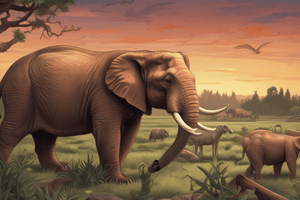Podcast
Questions and Answers
Healthy populations of game animals do not need to be kept at manageable levels.
Healthy populations of game animals do not need to be kept at manageable levels.
False (B)
Endangered animals continue to increase in number despite conservation efforts.
Endangered animals continue to increase in number despite conservation efforts.
False (B)
Plants and animals are interdependent, meaning they rely on each other for survival.
Plants and animals are interdependent, meaning they rely on each other for survival.
True (A)
The misuse of pesticides can harm our environment.
The misuse of pesticides can harm our environment.
When a species is on the endangered species list, it indicates that no efforts can save it.
When a species is on the endangered species list, it indicates that no efforts can save it.
Endangered animals are at risk of becoming extinct.
Endangered animals are at risk of becoming extinct.
Habitat destruction does not affect wildlife populations.
Habitat destruction does not affect wildlife populations.
Pollution has no impact on animals' survival rates.
Pollution has no impact on animals' survival rates.
The term 'endemic' refers to species found only in specific areas.
The term 'endemic' refers to species found only in specific areas.
Humans contribute to the threat faced by animals through settlement expansion.
Humans contribute to the threat faced by animals through settlement expansion.
Wild animals are increasingly being hunted for their fur.
Wild animals are increasingly being hunted for their fur.
Survival rates of endangered species are improving due to conservation efforts.
Survival rates of endangered species are improving due to conservation efforts.
The main threat to animals comes from natural disasters.
The main threat to animals comes from natural disasters.
The walis ibex is believed to have only lived in the Simein Mountains.
The walis ibex is believed to have only lived in the Simein Mountains.
The protected population of mountain Nyala is described as previously common in the region.
The protected population of mountain Nyala is described as previously common in the region.
The similarities between mountain Nyala and Mimililis bush buck include both inhabiting dense forests.
The similarities between mountain Nyala and Mimililis bush buck include both inhabiting dense forests.
The bushbucks living near water bodies are considered the main characteristics of the species.
The bushbucks living near water bodies are considered the main characteristics of the species.
Interactive reading strategies are intended to help make a text come alive.
Interactive reading strategies are intended to help make a text come alive.
The phrase 'fully endemic' refers to species found only in a specific area.
The phrase 'fully endemic' refers to species found only in a specific area.
The main components of an oral presentation typically include an introduction, body, and reference list.
The main components of an oral presentation typically include an introduction, body, and reference list.
Using clear language expressions is unimportant in structuring oral presentations.
Using clear language expressions is unimportant in structuring oral presentations.
Wildlife conservation aims to protect threatened plant and animal species as human populations encroach on their resources.
Wildlife conservation aims to protect threatened plant and animal species as human populations encroach on their resources.
A buffer zone is an area that provides no protection to core conservation areas.
A buffer zone is an area that provides no protection to core conservation areas.
Endemic species are those that can be found in multiple regions around the world.
Endemic species are those that can be found in multiple regions around the world.
Ecology studies include the interactions of organisms with each other and their physical environment.
Ecology studies include the interactions of organisms with each other and their physical environment.
An ecosystem refers only to non-living components of an area.
An ecosystem refers only to non-living components of an area.
Indiscriminate shooting involves carefully selected targets.
Indiscriminate shooting involves carefully selected targets.
The term 'threatened' refers to species that are likely to become extinct in the near future.
The term 'threatened' refers to species that are likely to become extinct in the near future.
Habitat is the place where an animal can find food, shelter, and water.
Habitat is the place where an animal can find food, shelter, and water.
Flashcards
Endangered species
Endangered species
A species at risk of becoming extinct.
Habitat destruction
Habitat destruction
Human actions that damage or remove an animal's natural living space.
Threat to animals
Threat to animals
Anything that puts animals at risk, such as habitat loss or hunting.
Reduced numbers
Reduced numbers
Signup and view all the flashcards
Drawing inferences
Drawing inferences
Signup and view all the flashcards
Past events
Past events
Signup and view all the flashcards
Human settlement
Human settlement
Signup and view all the flashcards
Shortage of resources
Shortage of resources
Signup and view all the flashcards
Inferential Questions
Inferential Questions
Signup and view all the flashcards
Walia Ibex habitat
Walia Ibex habitat
Signup and view all the flashcards
Mountain Nyala Population
Mountain Nyala Population
Signup and view all the flashcards
Mountain Nyala & Mimililis Bushbuck Similarity
Mountain Nyala & Mimililis Bushbuck Similarity
Signup and view all the flashcards
Bushbuck Water Proximity
Bushbuck Water Proximity
Signup and view all the flashcards
Referential Questions
Referential Questions
Signup and view all the flashcards
Interactive Reading Strategies
Interactive Reading Strategies
Signup and view all the flashcards
Oral Presentation Structure
Oral Presentation Structure
Signup and view all the flashcards
Oral Presentation Language
Oral Presentation Language
Signup and view all the flashcards
Endangered animals
Endangered animals
Signup and view all the flashcards
Conservation efforts
Conservation efforts
Signup and view all the flashcards
Interview
Interview
Signup and view all the flashcards
Prior knowledge
Prior knowledge
Signup and view all the flashcards
Interdependence of species
Interdependence of species
Signup and view all the flashcards
Subjective expressions for presentations
Subjective expressions for presentations
Signup and view all the flashcards
Conservation (wildlife)
Conservation (wildlife)
Signup and view all the flashcards
Buffer zone
Buffer zone
Signup and view all the flashcards
Endemic species
Endemic species
Signup and view all the flashcards
Antonyms- 'Everywhere'
Antonyms- 'Everywhere'
Signup and view all the flashcards
Ecology
Ecology
Signup and view all the flashcards
Ecosystem
Ecosystem
Signup and view all the flashcards
Habitat
Habitat
Signup and view all the flashcards
Study Notes
Vocabulary
- Vocabulary is the language and words used or understood by people.
- It's usually alphabetized and explained.
- Example: essential – necessary.
- Predominantly – domineering.
- Indiscriminate – everywhere.
- Endangered – risk of extinction.
- Survive – to stay alive.
- Habitat – living place.
- Extinct – disappeared or died out.
- Overlook – condone.
- Endemic – found only in a specific area.
Activity 1
- Complete a text with appropriate word forms (threat, pollution, trees, destroying, etc.)
Endangered Animals
- Many animals living on Earth are endangered.
- This means they are at risk of extinction.
- Examples include tigers, orangutans, turtles, and others.
Drawing Inferences
- Inferences are conclusions based on clues in the text.
- Texts may hint at past events instead of directly stating them.
- Logical guesses can be made based on details provided.
Activity 2
- Answer inferential questions based on pages 44-45.
- These questions relate to animals in the Simein Mountains and mountain Nyala.
- Comparisons are drawn to similar animals and their habitats.
- The questions ask about locations, characteristics, and protections of local animal populations.
Day 4
- The activity involves answering questions about words or expressions from a text.
Post-Reading (Oral Presentation)
- Presentations in general have three parts: introduction, details/body, and conclusion.
- Use expressions like, "First I will like to explain..." "Second, I will look at..." "Lastly, I will discuss the impacts...",
Vocabulary Development
- Conservation protects animal species from human encroachment on their resources.
- Buffer zones protect core areas, preventing negative impacts (e.g., non-native species, climate change).
- Endemic species are found only in a specific area.
- Example: Walia Ibex is endemic to Ethiopia.
Activity 5
- Find antonyms (opposite meanings) for vocabulary words like "everywhere," "overlooked", "similarity," and "important".
Day 7 (Ecosystems):
- Ecosystems are study of organisms, their interactions with each other and their environment.
- These interactions can be complex and diverse.
- Examples of biodiverse ecosystems are coral reefs and tropical rainforests.
Interviewing
- Interviews involves asking questions and getting answers on a topic.
- Interviewers should be well-prepared to guide the interview.
- Prior knowledge is useful to connect and understand responses.
Studying That Suits You
Use AI to generate personalized quizzes and flashcards to suit your learning preferences.
Related Documents
Description
Test your knowledge of vocabulary related to endangered animals and their habitats. This quiz includes activities focused on completing texts with appropriate word forms and answering inferential questions. Perfect for students learning about biodiversity and conservation.




